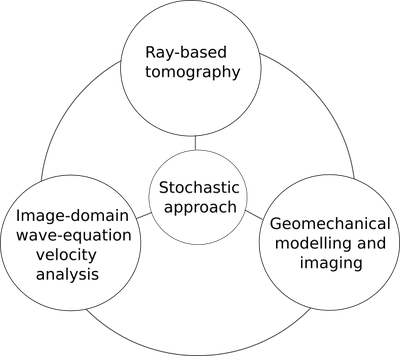Geophysics
Research activities
The research activities winth the Geophysical Research Group from MINES ParisTech is organised along three main axis:
Inversion Velocity Analysis – Stochastic tomography – Geomechanics

The three axis are complementary. In a more long-term prespective, the stochastic approach is the central part to evaluate reliable uncertainties
Its main research activities are the development of advanced seismic imaging tools, as well as the link between seismic imaging and geomechacnical modelling. Different scales are considered, from the near subsuface, the exploration scale to the seismological scale.
Permanent scientific staff
Pierre Dublanchet (Head) – Hervé Chauris – Alexandrine Gesret – Mark Noble
Administrative staff
Véronique Lachasse
More information on the team:
– Staff
– Publications
– PHD Positions
INVERSION VELOCITY ANALYSIS
The objective is to derive an initial model for subsequent Full Waveform Inversion. It consists of analysing focusing panels (e.g. Common Image Gathers). For the correct model, different images of the subsurface should be consistent.
The recent advances are:
-the derivation and introduction of a direct inverse (instead of the adjoint of the Born modelling operator) for much more macro-model gradients (Chauris and Cocher, 2017);
-the extension beyond reflected waves, with the incorporation of multiples (Cocher and Chauris, 2017) and transmitted waves (Lameloise and Chauris, 2016.
STOCHASTIC TOMOGRAPHY
In collaboration with the Geostatistics team, we have developed a research activity dedicated to the stochastic geophysics in order to reliably estimate uncertainties associated to the velocity model and to the seismic event locations (Gesret et al., 2015).
We recently focused on first arrival traveltime tomography with development of:
-efficient algorithms for both the forward problem (Noble et al., 2014) and the inverse problem (Boterro et al., 2016; Luu et al., 2018);
-parsimonious parameterizations of the velocity model (Boterro et al., 2016; Belhadj et al., 2018).
GEOMECHANICS
Our main contributions are the development and the study of mechanical models of frictional faults and frictional fault networks. We use these models to understand seismicity and aseismic deformations in diferent contexts (natural tectonic activity or induced by fluid operations at depth).
Recent advances concern
-the understanding of earthquake nucleation on a heterogeneous Dieterich-Ruina rate-and-state frictional fault (Dublanchet, 2018);
-the understanding of seismic activity induced by a fluid injection into a heterogeneous rate-and-state fault (Almakari et al., 2018).
PhD and postdoctoral studies
PhD students
Surveillance des infrastructures ferroviaires par méthodes multi-sismiques passives et satellitaires. Théo REBERT
Hydrogéophysique probabiliste pour une meilleure articulation des données géophysiques et modèles hydrogéologiques. Ramon SANCHEZ GONZALEZ
Urban Mining and WEEE sampling. Alexis BARTHET
History matching à la demande en transport réactif. Application à la récupération in situ de l’uranium. Antoine COLLET
Dynamique d’érosion fini-quaternaire dans le Bassin parisien par restitution de la géométrie 3D du mur des alluvions de fond des vallées de la Seine. Diana CHOURIO CAMACHO
Machine Learning et respect des lois de la physique : application à l’imagerie sismique. Léo DE SOUZA
Prise en compte d’incertitudes dans le traitement des données sismiques pour la caractérisation des réservoirs. Warren GUISTEL
Numerical modelling of fluid-induced fault slip reactivation – application to Geo-Energy systems. Jinlin JIANG
Evaluation des effets de sites topographiques dans les pentes soumises à des sollicitations dynamiques : simulations numériques et validations sur le terrain de Byblos.. Rita ABOU JAOUDE
Post-docs
Subsurface structures from seismic measurements at the surface : study of Inversion Velocity Analysis and associated tomographic Hessian. Carlos Andrés MARTINS DE ASSIS
Modélisation physique d’une séquence de sismicité induite dans un réservoir géothermique. Gianluca GERARDI
New seismic imaging approaches for the subsurface characterisation M. FARSHAD
Migration velocity analysis: selection of user parmeters and introduction of transmitted waves / Analyse de vitesse par migration : choix des paramètres utilisateurs et introduction des ondes transmises. Tianyou ZHOU
Hydro-mechanical rate & stage fault reactivation: slip, seismicity and permeability enhancement / Réactivation hydro-mécanique d’une faille rate & state – glissement, sismicité et évolution de perméabilité. Michelle ALMAKARI
4D seismic data analysis and processing for underground monitoring : time-lapse, continuous-time and real-time. Environmental Engineering / Analyse et traitement de données sismiques pour la suveillance du sous-sol. Julien COTTON
Seismic imaging˸ strategies for visco-acoustic full waveform inversion / Imagerie sismique : stratégies d’inversion des formes d’onde visco-acoustique. Hao JIANG
Ambient noise spectral amplitude distortions above heterogeneities : feasability study for multi-fluid reservoir exploration and monitoring / Perturbations d’amplitude du bruit ambiant au droit des hétérogénéités : étude de faisabilité pour l’exploration et la surveillance de réservoirs multi-fluide . Alexandre KAZANTSEV
Numerical optimization using stochastic evolutionary algorithms : application to seismic tomography inverse problems /Optimisation numérique stochastique évolutionniste : application aux problèmes inverses de tomographie sismique . Keurfon LUU
Subsurface seismic imaging based on inversion velocity analysis in both image and data domains/Analyse de vitesse par migration quantitative dans les domaines images et données pour l’imagerie sismique. Yubing LI
Significance of Coupling of Distributed Fibre Optic Sensor Systems for Vertical Seismic Profiling / Importance du couplage des capteurs distribués à fibre optique dans le cadre des VSP. Sven SCHILKE
Iterative Migration Velocity Analysis : extension to surface-related multiple reflections / Analyse de vitesse par migration itérative : vers une meilleure prise en compte des réflexions multiples. Emmanuel COCHER
Modèles paramétriques pour la tomographie sismique bayésienne. Jihane BELHADJ
Signal separation in convolutive mixtures : contributions to blind separation of sparse sources and adaptive subtraction of seismic multiples / Séparation de signaux en mélanges convolutifs : contributions à la séparation aveugle de sources parcimonieuses et à la soustraction adaptative des réflexions multiples en sismique. Yves-Marie BATANY
